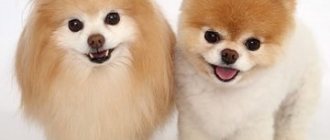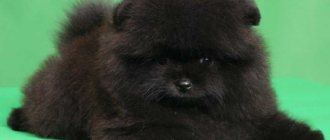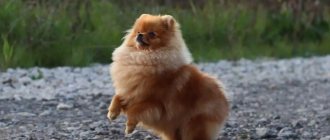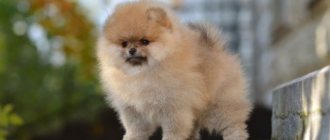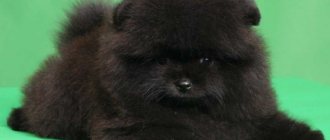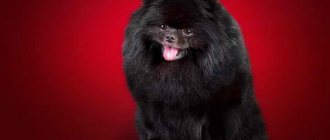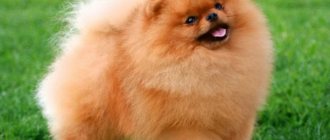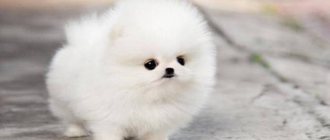The bear-type Pomeranian is one of the most popular breeds in the world. These friendly creatures look like a plush toy. Even Queen Victoria once could not resist the fluffy Spitz, and now they are actively conquering the Internet.
Pomeranians became models for paintings by great artists, their images were found on ancient coins, and they were filmed in films. They became companions for many famous scientists, musicians, writers and actors. What is the secret of the charm of these plush creatures?
Brief history of origin
The most distant ancestor of the miniature bear-type Spitz is considered to be the wild “peat” dog. Active work on the breed was carried out in Pomerania. The first Spitz dogs were bred there, weighing about 18 kg. The breed was used for grazing livestock and performed a guard function.
The first representative of this breed was brought to England by Queen Charlotte in the 28th century. Her granddaughter Queen Victoria began breeding dwarf oranges. Thanks to selection work, it was possible to reduce the weight of oranges to 9 kg. In 1870, the breed was officially registered. In 1871, the first Pomeranian Spitz club opened.
Initially, all Pomeranian dogs had a fox-type muzzle. Work on the bear type of Pomeranian began much later. The Teddy Bear is not a separate breed, but the new type of appearance of the Pomeranian has captivated many: dogs weighing about 3 kg, attracting the eye with an unusual toy face.
Grossspitz, up to 45 cm
They are also called Greater German Spitz . They weigh from 17 to 22 kg, grow to 40-50 cm at the withers. They can be brown, white and black. Grossspitz are smart dogs and easy to train. They need long walks in the fresh air, and their owner is nearby at any time of the day, because... they cannot stand loneliness.
These are kind, well-mannered, active dogs that tolerate children's pranks and can become good guards. They can get along with other pets.
Bear-type Pomeranian: interesting facts
- “Spitz” is translated from German as “sharp.” The Germans also use this word to call scammers.
- The ancient ancestors of bear-type Pomeranians are northern sled dogs. It was from them that the bears got their warm and fluffy fur.
- As a result of the sinking of the Titanic, only three dogs were saved from the ship. Two of them were Spitz dogs.
- According to legend, the wise men who went to worship the newborn Jesus traveled the entire route accompanied by three Spitz dogs.
- Spitz dogs appear in the stories “The Lady with the Dog” by Anton Chekhov and “The Legend of Ulenspiegel” by Charles de Coster.
Owners' opinion
Little “Pomeranians” cannot get along in the same house where lazy and passive owners live. Due to its activity, this breed needs a person with the appropriate character, which will allow the pets to splash out the accumulated energy, and completely! This can be confirmed by anyone or anyone who has such a sweet, loyal and brave companion of animal origin.
These are wonderful companions for human beings of any gender and regardless of age:
- men;
- women;
- children;
- teenagers;
- To old people.
At the same time, such a pet has several individual traits of natural origin. First of all, it is worth noting the vertical position of the coat, which is why the dog looks attractive and “fluffy” in appearance.
In addition, in the absence of proper training, you can hear random barking all the time, which becomes excessive. And it should be noted that these smallest Spitz dogs have quite a ringing voice!
Now it is worth citing evidence in favor of the insight that dogs are capable of showing, even while in puppyhood. As soon as the pet feels the lack of persistence on the part of the owner during the upbringing period, he can begin to show his character. This manifests itself in the form of stubbornness or ignoring the execution of any command.
Breed description, standards and appearance
The bear-type dwarf Pomeranian is not identified as a separate breed. To participate in exhibitions, the bear must meet the breed standards that apply to fox-type Spitz dogs. And here the difficulties begin, since bear-type Spitz have serious differences from the breed standard.
The standard specifies the size of the dog and its reference height. The height of a Pomeranian bear can be from 18 to 22 cm. The weight should correspond to the height of the dog. On average it is 3–3.5 kg.
The bear-type Pomeranian has a square-shaped body: the ratio of height to length should be 1:1. The loin is strong and wide. The chest is powerful. The limbs are parallel to each other, straight. The tail is raised high and has a rounded shape.
The muzzle is round. The forehead is wide and rounded. The ratio of muzzle length to skull length is 2:4. An adult dog must have 42 teeth, but several premolars may be missing. The bite can be pincer-shaped or straight. The eyes are oval-shaped, dark.
You can distinguish a bear-type Spitz from a fox-type one by the following characteristics. The bears have fluffy round cheeks, a short, slightly snub nose, close-set eyes, and triangular ears, the tips of which are slightly curved inward. In the fox type, the muzzle is more elongated, the cheeks are not so fluffy, the ears are straight and wider apart.
Important! It is possible to visually distinguish representatives of different types of breed only when the puppies are 4 months old.
Color and coat type
Due to the rich undercoat, every hair on the Miniature Spitz's body stands perpendicular to the skin. The longest hair is on the collar and hind legs. The short tail is characterized by increased fluffiness. The Pomeranian's coat should not be curly or wavy. It can only be straight. There should be no parting on the back.
Black and white bear-type Spitz are the least common, as it is difficult to achieve a uniform color. More common colors of Pomeranian bears: brown, orange, zenary gray.
Care
For a child who has arrived in a new home, the apartment seems like a different world. New smells and strange objects can frighten the puppy, and he will hide in a secluded corner. To avoid stress for the dog, you need to take care of a safe house in advance. It is better to take a towel with the scent of the mother dog from the breeder and put it in the enclosure. This will give the puppy peace of mind and he will quickly get used to his new home. Usually five to seven days is enough for the baby to feel at home. The enclosure should have a basket with low sides in which the puppy will sleep. If the “bear cub” is left alone, then for safety you need to lock him in the house. When the owner returns, the dog will be happy and play. For the sake of these entertainments, he is ready to wait.
During the first acquaintance with the new house, the puppy will be nervous and look for a secluded corner
Leaving a baby without an enclosure in an apartment can be very dangerous. The tiny size of the dog will allow it to get into hard-to-reach places, but he will not be able to get out on his own. Wires, linoleum, wallpaper, shoes can become entertainment and a toy for a puppy; if he bites off a small piece, the baby may choke.
A stained carpet will also not be a joy for the owner returning from work.
A bowl of water and a portion of food should be available to the dog. While waiting, you can put a bone from the veins. It is better not to leave toys or balls in the enclosure; the dog may bite off a piece of rubber and swallow it, and this is a foreign object in the stomach - very dangerous for the baby.
After a long wait, when the owner returns home, it is necessary to play with the dog or take it for a walk. You need to take a leash and collar, toys and treats with you. In damp and rainy weather, you can put a Bolognese overall on your puppy; it will protect the puppy’s coat from contamination; you won’t have to wash the baby, but simply wipe the paws and tummy with a damp cloth.
The dog's flat muzzle does not allow it to cool and warm the air. When the frost is -15 degrees or less, you should avoid walking. The icy air does not have time to warm up, and the pet may catch a cold. Hot weather is also not the best time for a mini Spitz. Dry and hot air does not cool down, the dog begins to breathe frequently, but the body does not cool down, which can lead to overheating.
If the temperature outside is too high or low, it is better to avoid walking
Playing with a Spitz, communication and care will be the best motivation for him to be obedient and beautiful.
Diet features
All representatives of the breed are terrible gluttons. The owner needs to control the mini-Spitz's portions and not overfeed.
The dog's miniature size does not allow it to swallow large pieces of food. Meat must be cut into pieces or passed through a meat grinder, vegetables must be grated. Chicken, lamb or beef should make up 70% of the diet, vegetables and cereals - 30%. Buns, sweets, and cakes should not be fed to Spitz dogs.
For light colors: white, cream, sand - it is better to exclude all products that cause allergies. Light colored dogs often suffer from allergic reactions to food.
During the period of active growth of the Spitz from 4-8 months, it is necessary to add vitamins to the diet for puppies of small breeds. This is a period of active molting; brushing and adding sea fish to the diet will help the body cope with the change of coat.
During active growth, puppies need more vitamins
A fur coat is an indicator of a healthy dog and proper feeding of the pet; a lack of vitamins A, E, F will affect the animal’s coat - it will become dull and matte.
Hygiene
An active and playful dog with sparkling eyes and fluffy fur requires the owner’s time not only for games, but also for caring for the dog’s amazing appearance. The Spitz coat consists of two layers: the undercoat and the center hair. You need to comb out the baby twice a week. Due to their small size, Spitz dogs do not have an unpleasant odor, so you should wash your dog with shampoo no more than once every three months. Inspect the dog's ears and mouth weekly. Milk teeth, due to the short muzzle of the “bear cub,” cannot fall out on their own; if necessary, they must be removed. Tartar on molars is another reason to visit a veterinarian.
In damp weather, dogs can get mites in their ears. With this disease, brown discharge appears on the auricle and has an unpleasant odor. Weekly checkups will help keep your ears healthy.
If the dog travels with the owner, walks in the forest and park, it is necessary to treat the dog’s fur with tick drops in the fall and spring.
Grooming
Usually a bitch will have two or three puppies in a litter, but not every baby will become a bear type. The dwarfism gene is quite rare, and it is impossible to understand which of the puppies in the litter will become bear or fox. All babies at the age of two months look like bear cubs. As the dog grows, the shape of its head changes.
Some owners want their adult Pomeranian to look like a bear cub. An excellent solution would be to take your pet to an experienced groomer. Grooming salons offer all kinds of haircuts for mini Spitz. It is not difficult for a craftsman to give a chic Spitz collar a round teddy bear shape.
After a haircut, a dog can look like an exact copy of a bear cub
First, the master aligns the center hair and undercoat - they become the same length. This gives the fur a toy-like appearance. Then the head is cut, as a result the Spitz's head becomes round, like a bear's.
It is impossible to cut a Spitz very short under velor, he risks wearing such a hairstyle for the rest of his life. If you cut off the inner layer of wool, which is not restored, then the undercoat and center hair will stop growing.
If your pet attends exhibitions, then there will be hairstyles for him too. A dog groomer can add volume to the collar and pants and trim the fur on the paws.
Character and behavior
The bear-type Pomeranian is energetic and friendly. This is a loyal breed that, in case of danger, does not hide, but hurries to protect its best friend.
Bears are cheerful and active. They love to play and need their owner's attention.
Pomeranians love to bark - this is how they show their protective qualities. In addition, bear-type Spitz can easily rush at other animals and even people if they perceive them as a threat. That is why proper attention should be paid to raising a Pomeranian bear.
The bear cub tends to copy the habits and behavior of the owner. It can repeat a person's gait, and even recreate some sounds. Bear-type Pomeranians also copy the temperament of their owner. Living with an introvert, the bear becomes a calm homebody. Next to an extrovert, the Pomeranian Spitz is as emotional and active as possible.
Pomeranians treat small children well. However, do not forget that the dog itself is small in size, which means it can easily be harmed by a child who does not yet know how to properly handle pets.
American Eskimo dog, up to 48 cm
The breed appeared at the beginning of the twentieth century, when German Spitz dogs were brought to the United States. At that time, anti-German principles were developing in America, so they were renamed American Eskimo Spitz . Gradually a new decorative breed was formed.
They weigh from 2.7 to 16 kg, there are standard Eskimo Spitz, whose height can be up to 48 cm, as well as miniature - up to 38 cm and toy - up to 30 cm. They have a thick and soft coat of only white color, without spots. But a cream shade is allowed.
Very friendly, cheerful dogs, but can be excellent guards. The American Eskimo Spitz is disciplined, intelligent, follows commands well, quickly finds a common language with children, and can make friends with other animals.
It is considered one of the most docile varieties of Spitz, and is not at all aggressive. They love to play in the snow; for them this is the most desirable entertainment.
How to choose the right Spitz puppy?
When purchasing a bear-type Pomeranian, you should pay attention to the fact that often unscrupulous sellers pass off puppies of one type as another. Until 4 months of age, it is almost impossible to distinguish a bear-type Spitz puppy from a fox-type one.
The choice should be a well-known nursery that has positive reviews. This way you can protect yourself from deception and be confident in the health of your bear-type Pomeranian puppy. All puppies in the kennel must be vaccinated according to age. You can check their presence in your pet’s passport.
When choosing a puppy, you should pay attention to how its parents behave and feel. If Pomeranians are aggressive, behave inappropriately or are overly passive, similar problems can be observed in the offspring.
In Moscow nurseries, prices for bear-type dwarf Spitz start from 20,000 rubles.
Breeding Miniature Spitz
Bitches of this breed begin to go into heat at about one year of age, but breeding cannot be done right away. Only after the dog reaches 2 years old can you plan to have offspring. Males are bred at 18 months. Bitches come into heat twice a year and last up to 22 days. Before mating, it is imperative to show the animals to a veterinarian.
Dogs are bred after they reach two years of age.
If the bitch is sick, weakened or has signs of obesity, it is better to wait a little while getting offspring. The gestation period for this breed is 63 days. If labor begins on day 57 or earlier, there is a high probability of stillbirth. There can be from 1 to 3 puppies in a litter. During pregnancy, the bitch must be protected from jumping from high heights, hypothermia, blows, etc. In addition, she requires high-quality nutrition.
Due to the small size of Pomeranians, childbirth often occurs with complications. The owner of a bitch needs to be prepared for the fact that the dog will need to be urgently taken to the clinic for a cesarean section. Severe complications occur especially often during the first birth. It is advisable to let the bitch eat the afterbirth, because... this will help normalize her condition and increase her immunity.
The muzzles of newborn puppies should be freed from the amniotic sac. They need to be held upside down so that fluid comes out of the respiratory tract.
Puppies
When buying a puppy, you should remember that after the first molt, bears change their appearance greatly. Month-old puppies look like little fluffy bear cubs. When the first molt begins, the puppies will become ugly and shabby, which can scare away potential buyers. Therefore, breeders strive to start sales as early as possible.
An owner who purchases a small Bear Pomeranian puppy needs to be prepared that serious changes in the cub’s appearance will soon begin. There is no need to be afraid of this, because when the Pomeranian bear grows fur, its beauty will return.
The diet of a bear-type Pomeranian puppy should include dairy products. You can exclude them from the diet when the bear is one year old. If a Bear Spitz eats dry food, it should be appropriate for the puppy's age.
Food for adult representatives of the breed does not contain sufficient amounts of vitamins and microelements necessary for the development of a growing organism.
Expressive muzzle
Adorable dogs of the Pomeranian Spitz breed are distinguished by an elegant and slightly elongated muzzle, which in appearance is similar to the physiognomy of a fox.
As for the shape of this expressive part of the body, it can be one of three varieties:
- Bearish.
- Fox.
- Toy.
The bear's face is flattened and rounded in shape, with fluffier fur on the cheeks. The eyes are located in close proximity to the nose. These features are reminiscent not of a miniature dog, but of a small bear cub. When you meet something like this in the middle of an unfamiliar area, you can’t help but look around in search of an angry mother.
The more elongated fox face gives a truly believable resemblance to this cunning forest dweller. They even have a longer tail than other representatives of the Spitz breed.
As for the toy look, this form was imported straight from Japan. The muzzle is flatter compared to the first type. The eyes are located higher and further apart.
What is characteristic is that it is the fox form of the smallest Spitz in the world that is allowed to participate in competitions, while the remaining varieties appear as pets. In the standard characteristics section there is a description of the fox type.
Care and maintenance
It's easy to care for the bear. These are not demanding animals. But Bear Pomeranians have features that should not be forgotten.
You can find out how to properly care for your Pomeranian in the article “Rules for keeping a Spitz.”
The right diet
Most breeders and veterinarians advise feeding cubs with high-quality premium food. Their advantage over natural food is that the composition of the feed is perfectly balanced, it contains all the necessary microelements and vitamins.
Vaccinations and susceptibility to disease
The first vaccination is given to the puppy at 8 weeks of age. A few months later the cub is vaccinated again. Information about all vaccinations must be included in the animal's passport. An unvaccinated puppy should not be walked outside. Vaccinations are done annually.
The smaller the dog, the more diseases it is prone to. This rule also applies to Spitz dogs. Bears are prone to certain diseases due to the shape of their nose. The shorter the dog's muzzle, the more problems arise with the respiratory tract, the shape of the teeth and the bite. Considering that the most popular are Spitz dogs with “flat” faces, they are also characterized by these problems.
Pomeranians are prone to obesity. It is important to monitor the size of daily food portions and also take your pet for long daily walks.
Pomeranians live, as a rule, 12–15 years, sometimes living up to 18. Despite the tendency to a number of diseases, this is one of the longest-living dogs.
Disqualifying faults
Physical and mental defects considered grounds for disqualifying a dog from participation in breeding work and exhibitions include:
- apple-shaped head;
- strong narrowing of the black box;
- light color of the iris;
- flattened head shape;
- watery and overly bulging eyes;
- double ring on the tail;
- tittup;
- bodily pigmentation of the nose, eyelids and lips;
- excessively cowardly or aggressive behavior;
- half-drop ears;
- non-healed fontanel in an adult dog;
- malocclusion;
- inversion and eversion of the eyelids, etc.
Physical defects include watery eyes.
Pros and cons of the breed
A toy-looking dog is a living creature that has advantages and disadvantages:
| pros | Minuses |
| Unpretentiousness | Thick coats require careful grooming |
| Small size, which means it’s easy to keep the dog in the apartment | Spitz cubs love to bark loudly and loudly |
| Easy to train to go to the toilet using a tray | Energy can irritate calm people |
| Lack of aggression towards other pets and children | Can only be kept indoors |
| Loyalty, intelligence and ease of training | Tendency to a large number of different diseases |
Bear-type Pomeranians are very sweet, friendly, and easy to care for dogs. They are perfect for families with children and other pets.
Any child will be delighted with the toy appearance of the dog, it is only necessary that adults take care of both and explain to them safety precautions and the rules of living together. Even older people and teenagers can cope with such a pet.
Color
The dwarf Spitz would not have become so popular if it were not for the color of its fur! Moreover, this breed is distinguished by its double coat:
- awn;
- under-guns.
The fur of the smallest Spitz is elastic and at the same time very dense. The collar of an adult specimen can be seen. But besides this, other characteristic features may be noticeable, be it “pants” or “feathering” (on the back of the forelimbs).
All teenagers (meaning people) are going through a difficult time associated with the appearance of acne on their face. These animals also have something similar - at an early age, the dog’s fur does not look very presentable. In relation to adult representatives, this is equivalent to marriage. Not every dog breeder is familiar with this characteristic.
Representatives of the Pomeranian Spitz breed are often perceived as having a red color. However, there are other variations of the shade:
- black;
- zonal (gray);
- white;
- orange;
- brown;
- cream.
At the same time, among this color range you can often find Spitz dogs with a red color.
